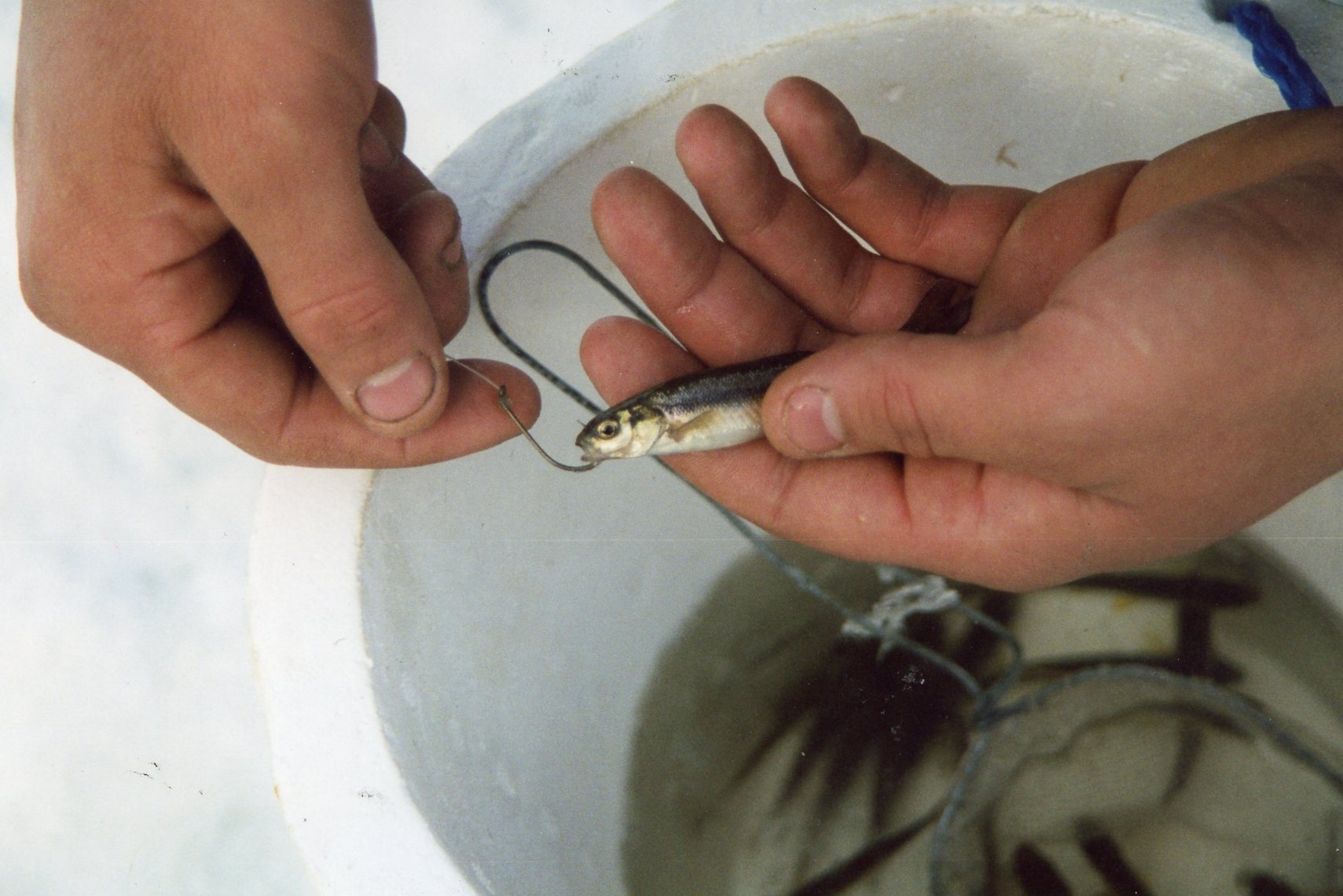
Some ice fishermen walk into a bait shop, plunk down their bucket and their money and then happily head for the lake with whatever size, shape and species of bait fish the owner has dipped out. Other winter anglers stand over the bait dealer’s shoulder pointing out the exact minnows they want, or in many cases they actually select and net their own bait.
Experienced ice drillers know that certain lakes and varied species of game fish require particular live bait to produce consistent action. No matter where, when or for what quarry you’re ice fishing, the species, size, condition and method of hookup of each live bait is crucial to success.
Over the years it’s become apparent to me that care and proper presentation of baits becomes even more important to fool fish during the second half of the season. As a general rule for bragging-size trout, salmon and togue, smelts are the most dependable live bait. For most outings, 5- to 7-inch smelt are the prime size. Despite their effectiveness in attracting game fish, these shiny silver daters have several shortcomings.
First off, they’re noticeably expensive at $15 a dozen. Furthermore, they are often scarce since bait dealers keep far fewer smelt on hand than other species of bait fish. Smelt tend to be fairly fragile compared to minnows. They don’t travel well in bait buckets, they are susceptible to severe water temperature changes, and if grabbed and released by a game fish, smelt often won’t survive when other bait fish will.
It’s not unusual to use up twice as many smelt during an outing as you would minnows, but for many anglers that’s acceptable. Despite being a bit frail and fairly expensive, smelt are just more productive when seeking big fish.
Check smelt baits often, at least every 30 minutes and at any decline in activity level, hook on a fresh smelt.

Josh Ash of Ashland uses an ice scoop to pick out a bait fish to hook on his tip-up. He uses a small drink cooler to keep just a few minnows from the larger bait bucket to carry between the several traps. (Courtesy of Bill Graves)
When it comes to selecting minnow species for ice fishing, the variety is wide and choice is mostly dictated by personal preference. Black nose dace, silver shiners, and golden shiners are very popular, and all are very resilient and active once hooked up. Golden shiners in the 3- to 4-inch range have always been productive on brook trout, brown trout and splake for me. Silver shiners and larger dace seem to produce more salmon and they cost about $7 per dozen. Many “hard water” anglers who venture out at least a couple of times each week catch their own bait from neighborhood ponds legally open to setting out minnow traps.
I’m not sure if the old adage “use big bait to catch big fish” is always true, but for muskie fishing, hooking on an 8- to 12- inch sucker seems to entice double-digit “water wolves.” Not all bait dealers keep a supply of suckers in their bait tanks, and when available they cost at least $2 apiece. On the plus side, suckers are hardy and travel well and stay active for hours once hooked up and set under the ice for bait.
On all-day outings, it’s important to keep bait buckets well aerated to keep bait fish active and healthy. If a small aerator isn’t available, changing about a third to half of the water every four hours will do the trick. If a large number of bait fish are being maintained in one container, say 40 to six dozen, proper aeration and water changes every two hours will assure lively bait all day long.
To many winter anglers, how a bait fish is hooked up is as important as species and size. Some swear a game fish grabs a minnow and turns it to be swallowed head first; therefore, hooking the bait through the lips will assure a better chance to hook up. Hooking bait through the lips also seems to allow very free, natural movement as the minnow swims about.
Another popular method of attaching a minnow is through the back muscle just behind the dorsal fin. This is popular for smaller baits, which are often grabbed from the side by a large quarry and swallowed as the fish turns to swim away. I prefer this method and maintain a good hookup-to-flag ratio. The use of circle hooks can further ensure solidly hooking a game fish with less chance of pulling free.
A few anglers hook their shiners near the tail. This of course impedes swimming ability, and gives the look of an injured bait fish, which supposedly further entices a game fish to grab the bait. No matter how a bait fish is hooked up, I’ve found that not setting the hook until a game fish has stopped taking out line works well. This is usually when the minnow is being swallowed. Once a run stops, gently take up slack, visualize the angle of the line and set the hook directly opposite. Keep a steady pressure during the tug of war with no loose line and your percentage of fish on the ice will increase.
In conclusion, I will readily admit that on many outings with friends we have all done a few things different with our traps and baits, and at the end of the day it was often more good luck than good management that produced the largest or the most fish. Often there’s equal amounts of fun and frustration, especially in ice fishing where the angler surrenders all control of the bait once it goes through the ice.







